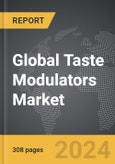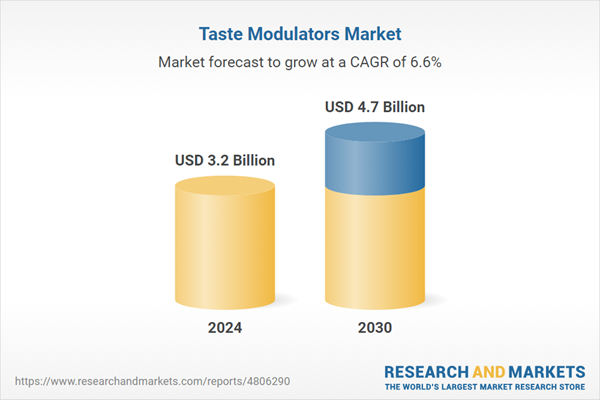The global market for Taste Modulators was valued at US$3.2 Billion in 2024 and is projected to reach US$4.7 Billion by 2030, growing at a CAGR of 6.6% from 2024 to 2030. This comprehensive report provides an in-depth analysis of market trends, drivers, and forecasts, helping you make informed business decisions. The report includes the most recent global tariff developments and how they impact the Taste Modulators market.
Segments: Type (Sweet Modulators, Salt Modulators, Fat Modulators); Application (Beverages, Food).
Geographic Regions/Countries: World; United States; Canada; Japan; China; Europe (France; Germany; Italy; United Kingdom; Spain; Russia; and Rest of Europe); Asia-Pacific (Australia; India; South Korea; and Rest of Asia-Pacific); Latin America (Argentina; Brazil; Mexico; and Rest of Latin America); Middle East (Iran; Israel; Saudi Arabia; United Arab Emirates; and Rest of Middle East); and Africa.
The analysts continuously track trade developments worldwide, drawing insights from leading global economists and over 200 industry and policy institutions, including think tanks, trade organizations, and national economic advisory bodies. This intelligence is integrated into forecasting models to provide timely, data-driven analysis of emerging risks and opportunities.
Global Taste Modulators Market - Key Trends and Drivers Summarized
What Are Taste Modulators and How Are They Transforming Food and Beverage Industries?
Taste modulators are specialized ingredients that enhance or modify the taste profile of food and beverages without altering their nutritional content. They are increasingly used by manufacturers to reduce sugar, salt, and fat content in products while maintaining or even improving flavor. With the global rise in health consciousness, consumers are actively seeking healthier alternatives that do not compromise on taste. Taste modulators are critical in this shift, enabling brands to meet consumer demands for reduced-calorie, low-sodium, and functional foods. This is especially important in categories like soft drinks, snacks, dairy, and bakery, where indulgence and flavor satisfaction are key factors for consumer loyalty. Additionally, taste modulators are playing a pivotal role in the development of plant-based and alternative protein products, where they help mask undesirable aftertastes and enhance palatability.Where Are Taste Modulators Being Applied and What Sectors Are Seeing the Most Impact?
The application of taste modulators spans several food and beverage sectors, including confectionery, beverages, dairy, and snacks. In the beverage sector, they are used to create low-sugar formulations in products such as soft drinks, energy drinks, and flavored waters, helping companies comply with regulatory pressures around sugar content. The dairy industry uses taste modulators to develop low-fat versions of popular products like yogurt and cheese without compromising on flavor. Plant-based and alternative protein products are another major area of application, as these products often require modulators to improve taste and mouthfeel. Additionally, the demand for clean-label products is driving the use of natural taste modulators, particularly in markets where consumers are looking for transparent, minimal-ingredient products.What Trends Are Shaping Innovation in the Taste Modulator Market?
The taste modulator market is being shaped by key trends, including the rise of personalized nutrition, the increasing demand for plant-based products, and the regulatory push toward sugar and sodium reduction. Personalized nutrition is becoming a major trend, with consumers seeking products tailored to their specific dietary needs, including reduced sugar and enhanced nutritional content. Plant-based diets, driven by concerns over health, sustainability, and animal welfare, are propelling the demand for taste modulators that can enhance the taste of alternative proteins. Advances in biotechnology are also playing a crucial role in innovation, enabling the development of more effective and natural modulators that can mimic the taste of sugar and salt without artificial additives. In addition, regulatory frameworks, particularly in regions like North America and Europe, are pushing food manufacturers to reduce sugar and sodium content, further driving demand for taste modulation technologies.The Growth in the Taste Modulator Market Is Driven by Several Factors
The growth in the taste modulator market is driven by several factors, including rising health awareness, the increasing popularity of plant-based products, and regulatory pressures to reduce sugar and sodium content. As consumers continue to shift toward healthier diets, food and beverage manufacturers are investing in taste modulation technologies to meet these demands without sacrificing flavor. The growing popularity of functional foods and beverages is also a key driver, as taste modulators are essential in masking the bitterness of added nutrients. Furthermore, innovations in biotechnology are enabling the creation of more effective modulators, particularly those derived from natural sources, aligning with the clean-label trend. The global push toward sustainability and ethical consumption is accelerating demand for modulators in plant-based products, where they improve taste and texture. Overall, the taste modulator market is expected to experience significant growth as manufacturers seek to innovate in response to evolving consumer preferences.Report Scope
The report analyzes the Taste Modulators market, presented in terms of units. The analysis covers the key segments and geographic regions outlined below.Segments: Type (Sweet Modulators, Salt Modulators, Fat Modulators); Application (Beverages, Food).
Geographic Regions/Countries: World; United States; Canada; Japan; China; Europe (France; Germany; Italy; United Kingdom; Spain; Russia; and Rest of Europe); Asia-Pacific (Australia; India; South Korea; and Rest of Asia-Pacific); Latin America (Argentina; Brazil; Mexico; and Rest of Latin America); Middle East (Iran; Israel; Saudi Arabia; United Arab Emirates; and Rest of Middle East); and Africa.
Key Insights:
- Market Growth: Understand the significant growth trajectory of the Sweet Modulators segment, which is expected to reach US$2.6 Billion by 2030 with a CAGR of a 7.4%. The Salt Modulators segment is also set to grow at 6.5% CAGR over the analysis period.
- Regional Analysis: Gain insights into the U.S. market, valued at $853.9 Million in 2024, and China, forecasted to grow at an impressive 10.8% CAGR to reach $1.1 Billion by 2030. Discover growth trends in other key regions, including Japan, Canada, Germany, and the Asia-Pacific.
Why You Should Buy This Report:
- Detailed Market Analysis: Access a thorough analysis of the Global Taste Modulators Market, covering all major geographic regions and market segments.
- Competitive Insights: Get an overview of the competitive landscape, including the market presence of major players across different geographies.
- Future Trends and Drivers: Understand the key trends and drivers shaping the future of the Global Taste Modulators Market.
- Actionable Insights: Benefit from actionable insights that can help you identify new revenue opportunities and make strategic business decisions.
Key Questions Answered:
- How is the Global Taste Modulators Market expected to evolve by 2030?
- What are the main drivers and restraints affecting the market?
- Which market segments will grow the most over the forecast period?
- How will market shares for different regions and segments change by 2030?
- Who are the leading players in the market, and what are their prospects?
Report Features:
- Comprehensive Market Data: Independent analysis of annual sales and market forecasts in US$ Million from 2024 to 2030.
- In-Depth Regional Analysis: Detailed insights into key markets, including the U.S., China, Japan, Canada, Europe, Asia-Pacific, Latin America, Middle East, and Africa.
- Company Profiles: Coverage of players such as DSM Biomedical, Firmenich Inc., Flavorchem Corporation, Givaudan SA, Ingredion, Inc. and more.
- Complimentary Updates: Receive free report updates for one year to keep you informed of the latest market developments.
Some of the 12 companies featured in this Taste Modulators market report include:
- DSM Biomedical
- Firmenich Inc.
- Flavorchem Corporation
- Givaudan SA
- Ingredion, Inc.
- International Flavors & Fragrances, Inc.
- Kerry Group PLC
- Senomyx, Inc.
- Sensient Technologies Corporation
- Symrise AG
- The Flavor Factory
Tariff Impact Analysis: Key Insights for 2025
Global tariff negotiations across 180+ countries are reshaping supply chains, costs, and competitiveness. This report reflects the latest developments as of April 2025 and incorporates forward-looking insights into the market outlook.The analysts continuously track trade developments worldwide, drawing insights from leading global economists and over 200 industry and policy institutions, including think tanks, trade organizations, and national economic advisory bodies. This intelligence is integrated into forecasting models to provide timely, data-driven analysis of emerging risks and opportunities.
What’s Included in This Edition:
- Tariff-adjusted market forecasts by region and segment
- Analysis of cost and supply chain implications by sourcing and trade exposure
- Strategic insights into geographic shifts
Buyers receive a free July 2025 update with:
- Finalized tariff impacts and new trade agreement effects
- Updated projections reflecting global sourcing and cost shifts
- Expanded country-specific coverage across the industry
Table of Contents
I. METHODOLOGYII. EXECUTIVE SUMMARY2. FOCUS ON SELECT PLAYERSIII. MARKET ANALYSISSOUTH KOREAREST OF ASIA-PACIFICARGENTINABRAZILMEXICOREST OF LATIN AMERICAIRANISRAELSAUDI ARABIAUNITED ARAB EMIRATESREST OF MIDDLE EASTIV. COMPETITION
1. MARKET OVERVIEW
3. MARKET TRENDS & DRIVERS
4. GLOBAL MARKET PERSPECTIVE
UNITED STATES
CANADA
JAPAN
CHINA
EUROPE
FRANCE
GERMANY
ITALY
UNITED KINGDOM
SPAIN
RUSSIA
REST OF EUROPE
ASIA-PACIFIC
AUSTRALIA
INDIA
LATIN AMERICA
MIDDLE EAST
AFRICA
Companies Mentioned (Partial List)
A selection of companies mentioned in this report includes, but is not limited to:
- DSM Biomedical
- Firmenich Inc.
- Flavorchem Corporation
- Givaudan SA
- Ingredion, Inc.
- International Flavors & Fragrances, Inc.
- Kerry Group PLC
- Senomyx, Inc.
- Sensient Technologies Corporation
- Symrise AG
- The Flavor Factory
Table Information
| Report Attribute | Details |
|---|---|
| No. of Pages | 308 |
| Published | April 2025 |
| Forecast Period | 2024 - 2030 |
| Estimated Market Value ( USD | $ 3.2 Billion |
| Forecasted Market Value ( USD | $ 4.7 Billion |
| Compound Annual Growth Rate | 6.6% |
| Regions Covered | Global |









